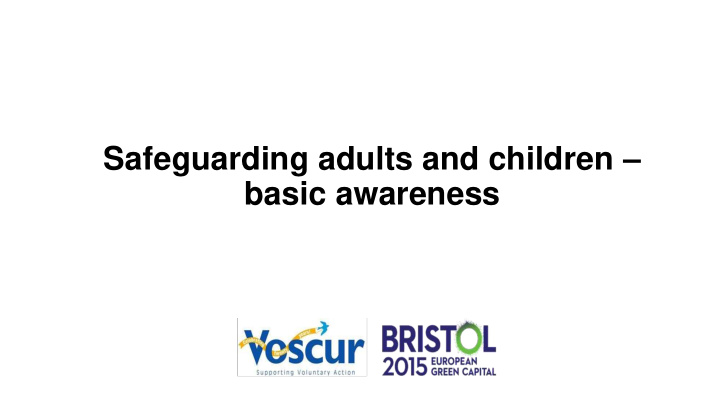



Safeguarding adults and children – basic awareness
What is safeguarding? Safeguarding is the process of protecting vulnerable groups including children from harm. It is everyone’s responsibility. Child Protection is part of this. This is the process of protecting individual children who are either suffering or likely to suffer from significant harm or abuse.
Safeguarding children Safeguarding children is defined in Working together to safeguard children (March 2015) as: • protecting children from maltreatment • preventing impairment of children's health or development • ensuring that children grow up in circumstances consistent with the provision of safe and effective care • taking action to enable all children to have the best outcomes
Safeguarding Adults The safeguarding duties apply to an adult who: • has needs for care and support (whether or not the local authority is meeting any of those needs) and • is experiencing, or is at risk of, abuse or neglect , and; • as a result of those care and support needs is unable to protect themselves from either the risk of, or the experience of abuse or neglect. (Safeguarding Adults Multi - Agency Policy 2015 http://www.bristol.gov.uk/page/adult-care-and-health/report- suspected-abuse-safeguarding-adults-risk
Key legislation • 2015 - Working Together to Safeguard Children • 2014 – Care Act • 1989 and 2004 – Children’s Act • 2000 – ‘No Secrets’
1 The Care Act 2014 replaces the ‘No Secrets’ Guidance for safeguarding adults. The Care Act 2014 sets out a clear legal framework for how local authorities and other parts of the system should protect adults at risk of abuse or neglect.
Safeguarding Policies and Procedures • What do you already have in place? Where are the gaps? • Who is taking the lead? • Involve everyone • Create a safeguarding and child protection policy • Create basic safeguarding procedures • Code of behaviour • Recruit the right people • Keep informed (adapted from safe network – are they safe?) • Make it work
Writing a child protection policy • The purpose of the policy: what, why, how, whom • The purpose of your group • Inclusive • Main law and guidance • Commitment that everyone is aware of safeguarding • Arrangements for regular review • All children have the right to be protected
Writing procedures What procedures do you need? • What to do when a person says they are being abused or shows signs of • How to manage allegations against someone in your group • Whistleblowing • Complaints • Anti-bullying • Reporting accidents and near misses • Guidance on technology
Writing procedures guidelines • Purpose and aim • Who it applies to • Summary of useful information • Clear directions • Contact details of key people • How, when and what information needs to be recorded • How relates to confidentiality • What to do if still concerned
Getting the message across Ensure everyone knows what is acceptable and what to do: Trustees, staff, volunteers, contractors, adults and children using your services • Easy to read posters or leaflets • Ensure your group is open to educating, assisting, talking and listening • Making it part of your group’s culture helps keep everyone safe
Making an alert Recognise Respond Record Report
Who to contact if there is a concern • Supervisor/line manager/organisation’s named lead • Care Direct (adults) – Tel: 0117 922 2700 • First Response (children) – Tel: 0117 9036444 In an emergency contact 999
What happens next? Specialist practitioners will assess the information gained together with any other information already received as well as liaise with other relevant agencies. Risk will be assessed to determine the appropriate course of action.
Recommend
More recommend